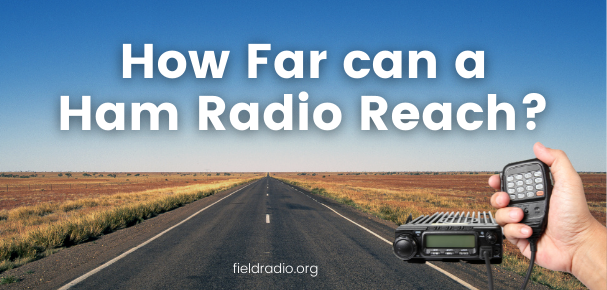Many people enjoy listening to the police radio. Some do it for fun, while others, the curious eavesdroppers, tune into police radio chatter to get as close to live-action as possible.
Police scanners help people pursue situational awareness and enable them to get the most authentic information when conventional media is unavailable or unreliable.
Being a Ham interested in staying abreast of public safety information, you may have considered using your trusty Ham radio to listen to police chatter.
But can a Ham radio listen to police frequencies? Well, it depends.
In this article, I am discussing all about listening to police frequencies on your Ham radio. So, stick around till the end to see if your amateur radio can pick up police chatter, and if so, on what frequencies.
More importantly, are you even supposed to eavesdrop on the police?
Let’s find out!
Can You Use A Ham Radio As A Police Scanner?
A police scanner is a one-way communication radio that receives police radio frequencies and helps monitor police communication.
So, can a Ham radio double as a police scanner?
The simple answer is, yes. You can use your Ham radio as a police scanner. However, there are lots of ifs that determine the veracity of this “yes”.
Ham radios and Police radios both operate on the VHF and UHF spectrum. This opens up the possibility of a Ham radio listening to police frequencies. But each of these devices, the Ham radios, and Police radios operate on their licensed frequency ranges.
Having said that, some Ham radios are programmed to transmit and receive only from the allotted ham radio frequency bands. But other radios have an extended receive coverage and can pick frequencies from the VHF and UHF bands on the public safety spectrums.
So, if your Ham radio has extended receive coverage, you might be able to receive analog radio signals from your local public safety departments.
But that’s not the only Ham radio requirement to tap into police frequencies and catch some live action.
Times have changed. Most police departments have now resorted to using digital frequencies for communications.
Your typical, inexpensive Ham radio most likely will not pick up digital signals.
Therefore, if your local police department relies on digital signals for radiocommunication, you will have to invest in a Ham radio that can receive these signals.
Okay. Is that it? A Ham radio with a wide receiving band and an ability to receive digital signals and you can listen to police frequencies? In most cases, yes. But, in some cases, nope.
You see, public security departments are likely to share some high-profile information over radio waves. In this case, they wouldn’t want curious Joes like you listening in.
Therefore, many police departments are now communicating over encrypted frequencies. And if your local police department is one of them, you may not be able to listen to their chatter through your Ham radio, or any radio for that matter.
So, to sum it all up, you can use a Ham radio as a police scanner if:
- Your Ham radio is programmed to receive frequencies beyond the allocated Amateur frequency bands.
- It can receive and interpret analog and digital signals, both in case the police radiocommunications have gone digital.
- The radiocommunications to and from your local police department aren’t encrypted.
See? Didn’t I tell you there were a lot of ifs!
What Frequencies Do Police Use?
Up until now, we have talked a lot about listening to the police radio chatter. But what exactly are the police frequencies that you can tap into for current, authentic, and unfiltered situational reports?
The Federal Communication Commission, FCC has a dedicated spectrum for the protection of life and property called the public safety spectrum, which lies in the VHF and UHF bands.
The public safety spectrum supports first-responders by aiding them in mission-critical communications. The FCC website lists the following frequency ranges in the public safety spectrum:
- 25-50 MHz (VHF low band) and 150-172 MHz (VHF high band).
- 220 MHz band.
- 450-470 MHz UHF band.
- 700 MHz broadband and narrowband.
- 800 MHz band.
- 806-809/851-854 NPSPAC Band.
- 4.9 and 5.9 GHz band.
Of course, there could be thousands of frequencies on the bands mentioned above. You will have to find and tune into specific frequencies to listen to police communication.
The specific police radiocommunication frequencies vary from locality to locality.
For example, the East Hampton Suffolk County police communicates on 155.9 MHz for law dispatch, while the police car-to-car communication frequency is 159.21 MHz.
Similarly, Sag Harbor Village police uses 158.82 MHz for communication. And if we move over to the west coast, Oregon’s Crook County police uses 154.115 MHz for law dispatch while the sheriff dispatch is at 154.89 MHz.
Finding your local police department’s frequency is simple.
All you have to do is log on to www.radioreference.com, search for your county or metro area or enter your Zip Code and the website will spit out a list of all radio frequencies. From here, you can find the police department frequencies, and any other frequencies you like and program them into your Ham radio.
Can You Transmit on Police Frequencies?
Ham radio is a transceiver, which means, unlike conventional police scanners it can not only receive but transmit signals as well.
So, given that a Ham radio is your go-to communication device for emergencies, can you use it to transmit on police frequencies?
The answer is no. Unless you are in a life or death situation and there are no other means of communication available. In that case, you can use your Ham radio for emergency communication with the police, or anyone listening.
But even then, the police might be a bit skeptical to communicate with you. They may not be sure whether you are a genuine station in distress or someone trying to ambush them.
Is It Legal for you to Listen to Police Frequencies?
Tapping into your police department’s radio communications may feel like a crime. But in reality, it is completely legal to listen to police frequencies, given that the frequencies are unencrypted.
You should not decrypt encrypted frequencies and listen to them!
However, before you jump on a police frequency, start listening and spreading what you find out, know that the law varies from jurisdiction to jurisdiction.
Some states have restrictions on how you use police scanners and listen to police frequencies.
Five states in the US, including Minnesota, New York, Kentucky, Indiana, and Florida have restrictions on listening to police radio chatter while driving.
While some other states have restrictions on using a police scanner for the furtherance of crime. These states include:
- California
- New Jersey
- Michigan
- Oklahoma
- Rhode Island
- South Dakota
- Vermont
- Virginia
- West Virginia
- Nebraska
If you live in one of these states and are planning to feed the information you got from listening the police radio to your felonious buddies, don’t.
Additionally, in some areas, you are allowed to listen to police frequencies privately. But the local law does not permit you to share what you have heard.
So, before programming frequencies in your Ham radio-turned-police scanner, check in with your local and state laws to see what you are supposed to do and what can get you fined or in jail.
Final Word
So, can a Ham radio listen to police frequencies? Yes. You can use a Ham radio to listen to police frequencies. But there are some requirements that must be satisfied before your radio can double as a police scanner.
Talking about the law, listening to police frequencies is legal. But there are certain restrictions in some states. So, go through your state’s radiocommunication regulations before tapping into police chatter.
As a final note, keep in mind that, while it is illegal and punishable, anyone can get on radio frequencies and transmit. That means, trolls and criminal-minded people can get on police frequencies and spread misinformation. So, don’t believe everything you listen to on the radio and always spread the information you know is accurate.

I have been passionate about the world of communications in its various forms for most of my life. Ever since I first found an old ham radio stashed away in my uncle’s attic, I have had a fascination with this classic technology.
Having the ability to communicate with people without the need to rely on telephone lines or networks is an empowering feeling which I believe everyone should have at least a basic knowledge of. Becuase who knows when you might need it?
I setup fieldradio.org with this passion in mind, to help inform people about the amazing possibilities of amateur radio and I’m on a quest to help educate as many budding operators as possible.
I hope you enjoy our content. Come and say hi, via our contact form


